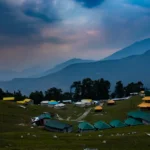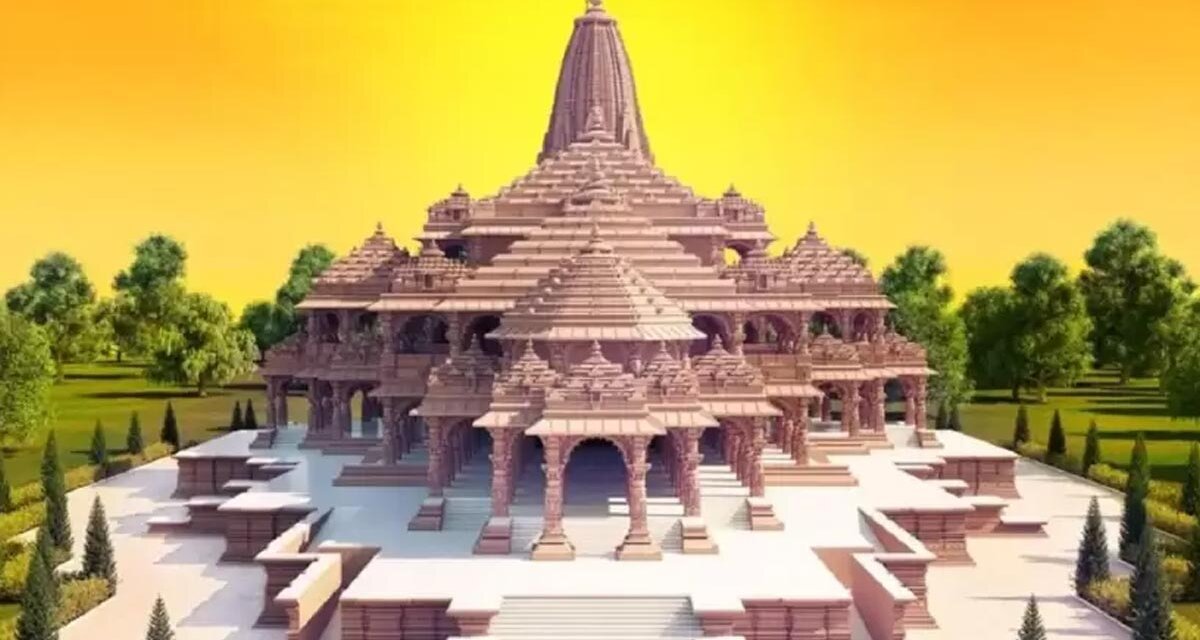
From Dreams to Reality: Ram Mandir Ayodhya Nears its Grand Opening

In Ayodhya, something really special is happening – the dream of building the Ram Mandir is becoming a reality! For many years, people like you and me have wished for this temple, which is super important for Hindus all over. The Ram Janmabhoomi matter has been a big topic of discussion, but now, after lots of talking and waiting, the temple is finally taking shape.
They started building the temple in 2020, and it’s not just any building – it’s a mix of ancient Indian art and modern construction. The temple area is going to be huge and beautiful, a place where people from all over can come to feel a deep connection with their faith.
In this blog series, we’ll explore how this dream turned into reality. We’ll look at the history, why this temple is so important, and how they’re making it look amazing. Join us as we discover the journey that led Ayodhya to the exciting moment when the Ram Mandir opens its doors, bringing a piece of mythology into our real world and showing how strong our belief as a community can be.
Important Facts About Ram Mandir
| Feature | Details |
| Location | Ayodhya, Uttar Pradesh, India |
| Significance | Considered the birthplace of Lord Rama, a principal deity in Hinduism |
| Construction Status | Under construction, expected completion in 2025 |
| Land Area | 70 acres, of which 70% is green space |
| Temple Size | Main temple: 380ft long, 250ft wide, 161ft high |
| Architectural Style | Nagara Style, with intricate carvings and sculptures |
| Number of Floors | 3 |
| Number of Pillars | 392 |
| Number of Doors | 44 (some to be gold-plated) |
| Mandapas (Halls) | 5: Nritya, Rang, Sabha, Prarthana, Kirtan |
| Foundation Material | 14-meter thick rolled compacted concrete with fly ash and chemicals |
| Granite Stone Source | Karnataka and Telangana |
| Sandstone Source | Bans Paharpur, Rajasthan |
| Teak Wood Doors | Gold-plated |
| Idols Material | Shaligram rock from Gandaki River, Nepal |
| Unique Features | No iron or steel used in construction, time capsule buried 2000 feet below |
| Significance of Construction | Marks resolution of a long-standing land dispute and holds religious and cultural importance |
Ram Mandir Ayodhya Specialities
- Traditional Nagara Style: The temple will follow the ancient Nagara architectural style, known for its tall spires and detailed carvings.
- Five Special Pavilions: The complex will include five pavilions for different purposes – a dance area, a colorful space, a prayer hall, a singing pavilion, and a meeting area.
- Materials Used: Pink sandstone will be used for the outside, while white Makrana marble will be used inside, giving the temple a beautiful and majestic look.
- No Iron or Steel: Instead of using modern materials like iron or steel, the construction will stick to traditional ones like wood, copper, and white cement for a strong and authentic build.
- Inscribed Bricks: Bricks with “Shri Ram” written on them will be used, adding a special touch of holiness to the construction.
- Solar Power and Green Practices: The temple will be eco-friendly with solar panels and other green features to reduce its impact on the environment.
- Modern Amenities: The complex will have modern facilities like ramps for easy access, a medical center, a bank/ATM, public restrooms, and a food area for the convenience of visitors.
- Museum and Learning Center: There are plans to create a museum and a learning center in the complex, sharing the history of the Ram Janmabhoomi site and Hindu culture.
- 2100 kg Bell: A massive 2100 kg bell, made from an alloy of eight metals, will be a special addition to the temple, enhancing its grand appearance.
Ram Mandir Bhoomi Poojan Ceremony
The Ram Mandir Bhoomi Pujan ceremony was a momentous occasion in India, marking the beginning of the construction of a Hindu temple dedicated to Lord Rama in Ayodhya. The event, held on August 5, 2020, was attended by Prime Minister Narendra Modi, various dignitaries, and thousands of Hindu devotees. The ceremony, filled with traditional Hindu rituals, symbolized the end of a long legal and historical dispute over the site.
During the ritual, priests chanted hymns and made offerings to the gods, while Prime Minister Modi laid the foundation stone for the temple. The atmosphere was charged with emotion as a large crowd cheered and chanted religious slogans, reflecting the culmination of a decades-long struggle by Hindus to reclaim the site they believe to be Lord Rama’s birthplace.
The Ram Mandir Bhoomi Pujan ceremony holds historical significance, portraying a sense of national unity and reconciliation. While the construction of the temple is expected to take several years, it is anticipated to become a major pilgrimage destination for Hindus worldwide.
Grand Opening Celebration Of Ram Mandir
The Grand Opening Celebration of Ram Mandir in Ayodhya on January 22, 2024, was a very special day for millions of Hindus in India. Ayodhya, believed to be the birthplace of Lord Rama, turned into a vibrant and colorful city filled with chants, music, and the smell of incense.
Before the big day, there was a week-long celebration called “Mandal Utsav” with cultural events, music, and religious talks. On January 22nd, the excitement reached its peak. The new Ram Mandir, a beautiful mix of traditional Hindu design and modern style, shone in the morning sun. Thousands of devotees, many wearing saffron robes, crowded the streets, their faces filled with happiness and tears of joy.
The most important part of the day was the “Pran Pratishtha” ceremony, where the idol of Lord Rama was placed in the temple. Prime Minister Narendra Modi and other important people took part in this sacred event, and it was shown live on TV all over India. The sound of Vedic hymns, temple bells, and the silence of the devotees created a strong spiritual atmosphere in the city.
When the news of the successful ceremony spread, celebrations happened all over the country. Temples were decorated, sweets were shared, and people joyfully marched in processions. The opening of Ram Mandir was not only about religion; it was a symbol of the whole country coming together, showing that faith and persistence can overcome challenges.
The Grand Opening Celebration of Ram Mandir in Ayodhya will be remembered by millions for a long time. It was a day that not only fulfilled a long-held dream but also brought back the sense of devotion and unity that ties India as one.
Special Guest
The event to open the Ram Mandir, Many different people are expected to come, with some already confirmed and others still considering attending.
- Confirmed Chief Guest: Prime Minister Narendra Modi
- Special Invitation: President Droupadi Murmu invited by the Ram Janmabhoomi Teerth Kshetra trust.
- State Dignitaries: Several state governors and chief ministers are anticipated to attend.
- Spiritual Leaders: Over 25,000 Hindu spiritual leaders from various traditions, including, heads of Akharas, and other prominent figures, have been invited.
- Celebrity Guests: Invitations extended to Bollywood and other film industry personalities, including Amitabh Bachchan, Rajinikanth, Madhuri Dixit, Akshay Kumar, and more.
- Religious Figures: Thousands of saints and seers from across India are expected to be present.
- Laborers’ Families: Invitations extended to the families of the laborers who contributed to the construction of the Ram Mandir.
- Public Participation: A limited number of invitations have been offered to the general public through a lottery system.
The opening ceremony of the Ram Mandir is a really big deal for Hindus in India. It’s going to be a huge event with lots of people attending.
Ayodhya Ram Mandir Aarti Timing
Ayodhya Ram Mandir Morning Aarti (Shiringar Aarti) timing
| Day | Timing |
|---|---|
| Sunday | 6:30 AM |
| Monday | 6:30 AM |
| Tuesday | 6:30 AM |
| Wednesday | 6:30 AM |
| Thursday | 6:30 AM |
| Friday | 6:30 AM |
| Saturday | 6:30 AM |
Ayodhya Ram Mandir Evening Aarti (Sandhya Aarti) timing
| Day | Timing |
|---|---|
| Sunday | 7:30 PM |
| Monday | 7:30 PM |
| Tuesday | 7:30 PM |
| Wednesday | 7:30 PM |
| Thursday | 7:30 PM |
| Friday | 7:30 PM |
| Saturday | 7:30 PM |
The Chief Architect of Ram Mandir
Chandrakant Sompura is the main architect of the Ram Mandir in Ayodhya. He comes from a family with a long history of designing temples, going back 15 generations, including the famous Somnath temple. Chandrakant, along with his architect sons Nikhil and Ashish, played a crucial role in creating the original design of the Ram Mandir in 1988 and later revising it in 2020 based on Hindu texts and architectural principles.
Their design for the temple follows the Nagara architectural style, known for its detailed carvings and tall shikharas. Chandrakant has received praise for his dedication and expertise in bringing this significant project to fruition. He believes that the temple, constructed using earthquake-resistant techniques, will endure for at least 2500 years, ensuring its strength for future generations.
Major Architectural Highlights of Ram Mandir
The Ram Mandir in Ayodhya is a beautiful piece of architecture inspired by Hindu temple design. Here are some key features:
- Nagara Style: The temple follows the Nagara style, with tall, pyramid-shaped towers called shikharas. These towers have a pot-shaped ornament, called a kalash, at the top.
- Panchayatan Layout: The temple has a panchayatan layout, meaning it has five shrines. The main shrine, garbhagriha, houses Lord Ram’s idol, while four smaller shrines for deities like Sita, Lakshmana, Bharata, and Hanuman are at the corners.
- Three-Storied Structure: The main structure has three floors, each serving a specific purpose. The ground floor contains the garbhagriha, while upper floors are for darshan and rituals.
- 392 Pillars: The temple has 392 pillars, each adorned with 16 idols of various deities, providing both structural support and spiritual significance.
- Five Mandapas: There are five pavilions for different purposes: Nritya Mandap (dance), Rang Mandap (color), Sabha Mandap (assembly), Prarthana Mandap (prayer), and Kirtan Mandap (devotional singing).
- Intricate Carvings: The walls and columns feature detailed carvings depicting scenes from the Ramayana, Hindu mythology, and floral motifs, showcasing the craftsmanship of Indian artisans.
- Golden Doors: Some of the 44 doors will be coated with 100 kg of gold, adding to the temple’s grandeur.
- Modern Techniques: While following traditional principles, the temple incorporates modern techniques like roller-compacted concrete foundation, sewage treatment, and water treatment plants for longevity and resilience.
The Ram Mandir’s design is a stunning tribute to Hindu faith and architecture, set to become a major pilgrimage destination and cultural landmark in India once completed.
Construction Cost & Timings of Ram Mandir
Construction Cost & Timings of Ram Mandir, Ayodhya are:
Construction Cost:
Initial Cost Estimate: The Shri Ram Janmabhoomi Teerth Kshetra Trust originally estimated the construction cost to be around Rs. 1,800 crore (approximately $220 million). This budget encompasses expenses related to construction materials, machinery, labor, and administrative needs.
Revised Projected Cost: However, due to potential expansions to the complex and unforeseen circumstances, there are reports suggesting that the final cost might escalate to Rs. 18,000 crore (approximately $2.2 billion).
Timings:
Anticipated Completion Date: According to the latest information, the construction of the temple is on track for completion by December 2024.
Inauguration Details: Prime Minister Narendra Modi is expected to officiate the temple’s inauguration ceremony after its completion.
Current Construction Progress: As of January 19, 2024, substantial advancements have been achieved in the construction of the main temple. Activities such as ground-level flooring, pillar construction, and stone carving are actively underway.
Major Construction Materials Used
The Ram Mandir in Ayodhya, India, is a beautiful temple being built with special materials. Let’s talk about the main ones:
- Bansi Paharpur Pink Sandstone: This comes from Rajasthan and is the main material for the temple. It’s pink and makes the temple look warm and elegant.
- Granite: A 21-foot black granite base protects against moisture and looks good.
- Roller-Compacted Concrete: This is strong concrete without steel, making a solid foundation for the temple.
- Shaligram Rock: Two old rocks from Nepal, 26 and 14 tonnes, were used to make the idol of Ram Lalla.
- Copper Plates: Instead of steel, there are 10,000 copper plates holding the stones together.
- Teakwood: The doors are made of strong and beautiful teakwood.
- Special Bricks: Bricks with “Shri Ram” written on them are used, making the building sacred.
- Gold and Ashtdhatu: Precious metals are used for decoration and making idols, making the temple grand and spiritual.
Ayodhya Ram Mandir Donations
The amount of money collected for the Ayodhya Ram Mandir varies depending on the source and date. Here’s a summary of the latest information:
Donation Collected:
- As of August 2023: The trust in charge of building the temple reported receiving over Rs. 3,200 crore in donations.
- In February 2023: During a special fundraising drive from January 15 to February 27, the Trust announced collecting Rs. 5,500 crore.
- Latest reports in January 2024: Some media sources mention that the donations have now surpassed Rs. 6,000 crore.
The Contributors in Donation:
- Spiritual Leaders: Morari Bapu has personally contributed Rs 11.3 crore, supplemented by an additional Rs 8 crore from his followers abroad. Other notable contributors include Swami Nityananda and Satya Sai Baba.
- Public Figures: Celebrities such as Akshay Kumar, Ajay Devgn, and Raveena Tandon have made generous donations. Politicians like Eknath Shinde and Nirmala Sitharaman have also contributed along with their respective parties.
- Industrialists: Notable industrialists like the Birla family, Jindal group, and Ambani family have made substantial donations.
- Shri Ram Janmabhoomi Teerth Kshetra Trust: This trust oversees the construction and fundraising efforts, receiving contributions from millions of individuals across India and abroad.
- Sangh Parivar Organizations: The Rashtriya Swayamsevak Sangh (RSS) and its affiliates have actively mobilized their members to contribute to the cause.
- State Governments: Several state governments have also made financial contributions towards the temple construction.
- Millions of Devotees: Countless individuals across India have made both small and large donations, collectively forming a significant portion of the funds.
- Crowdfunding Initiatives: Online platforms and grassroots campaigns have played a crucial role in collecting donations from a diverse and widespread audience.
How to Reach Ayodhya Ram Mandir
By Air
Nearest airports are:
Gorakhpur Airport(GOP) distance from Ayodhya is 118 Km
Amausi Airport (LKO), Lucknow distance from Ayodhya is 125Km
By Train
You can easily get regular trains to Ayodhya from other major cities of the country.
Ayodhya Junction(AY)
Faizabad Junction (FD)
By Road
Services of Uttar Pradesh Transport Corporation buses are available 24 hours a day, and it is very easy to reach here from all places
| States | Distance |
|---|---|
| Lucknow | 130 km |
| Varanasi | 200 km |
| Allahabad | 160 km |
| Gorakhpur | 140 km |
| Delhi | 636 km |
| Bihar | 374.5 km |
| Karnataka | 1,822.4 km |
| Punjab | 1,051.2 km |
| Arunachal Pradesh | 1,705.9 km |
| Manipur | 1,691.8 km |
| Madhya Pradesh | 721.2 km |
| Nagaland | 1,708.4 km |
| Meghalaya | 1,229.2 km |
| Uttarakhand | 720.8 km |
| Maharashtra | 1,230.9 km |
| Goa | 1,920.3 km |
| West Bengal | 852.7 km |
| Gujarat | 1,493.7 km |
| Tripura | 1,737.2 km |
| Kerala | 2,459.2 km |
| Rajasthan | 939.1 km |
| Odisha | 1,029.9 km |
| Telangana | 1,238.5 km |
| Chhattisgarh | 812.5 km |
| Mizoram | 1,776.8 km |
| Andhra Pradesh | 1,599.0 km |
| Assam | 1,357.8 km |
| Haryana | 811.7 km |
| Tamil Nadu | 2,197.6 km |
| Sikkim | 904.7 km |
Hotels Near Ram Mandir
Here are some hotels near Ram Mandir, Ayodhya:
| Hotels | Directions |
|---|---|
| Ramprastha Hotel, Ayodhya | Get Direction |
| Raghuvar Inn | Get Direction |
| Rama Residency | Get Direction |
| Shri Ram Hotel | Get Direction |
| Sri Janaki Mahal Trust | Get Direction |























